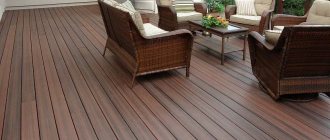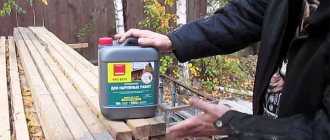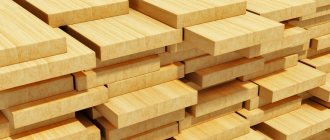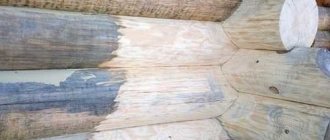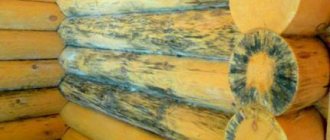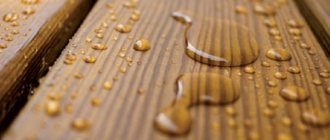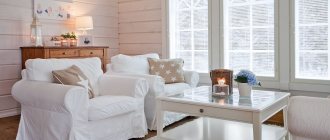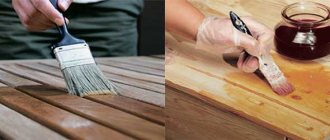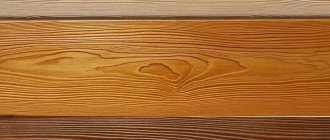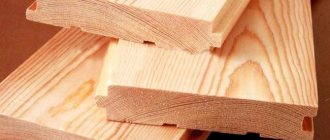Finishing of wood - what and how to coat the material.
The main enemies of wood are water and fire, the rays of the sun and living microorganisms, insects that gnaw on wood or choose it as a place for reproduction (here we are talking about mold fungi).
And wooden structures that are located in the open air especially need protection from aggressive opponents, which have a negative impact on the structure, affect the strength and appearance.
For this reason, the question of how to cover wood, especially outdoors, will be relevant for owners of a country house. When you get acquainted with all the variety of protective compositions, you will be able to choose the composition that is suitable for your purposes and will be affordable for you.
Why is processing needed?
Wood processing allows you to protect it from the destructive effects of ultraviolet radiation, as well as from fungus, mold, and insects. Otherwise, after 1–2 years the tree will lose about 90% of its mechanical stability, and the structure will simply collapse. Impregnation will also help preserve the natural pattern of the wood cut, and if you plan to apply paint on top, the treatment will reduce its consumption by 50–60%.
Another important nuance: impregnation of wood must be carried out in several passes. This is true for primers, natural and synthetic oils. Only in this case can a wooden gazebo be protected by 99% from environmental influences.
Fund options
Based on the composition of wood impregnation, it can be divided into:
- Antiseptics. For gazebos that are used outdoors, they are required, as they help prevent the occurrence of mold and mildew. It is impossible to prevent spores from getting onto the tree, but an antiseptic will prevent them from germinating. Some of the most popular: Farbex, “Titan” (S series).
- Oils. The most common options are linseed oil and drying oil. They protect against moisture. If you treat wood with them, its moisture absorption coefficient will decrease to approximately 0.2%. Accordingly, moisture will not accumulate in the wood and freeze in winter, which is why cracks most often appear.
- Primers. It is recommended to coat the wood with this product before painting - this increases adhesion and prevents cracking and fading of the paint layer. By the way, there are also primers with antiseptic additives. In many cases it is better to use them. Popular models: Pinotex, Kompozit.
- Varnish. It completely covers the wood, so it is applied only to well-dried wood. Allows you to preserve the natural pattern of wood materials, but at the same time perfectly protects against moisture, fungi, mold, and ultraviolet radiation. Popular models: Euromix, Mav Brava.
- Dye. It is better to use an oil-based product, as it penetrates deeply into the wood structure and does not create an outer polymer film. But the consumption is quite large, even with preliminary priming. Popular paints: Kompozit, Bayris.
Manufacturers
The impregnation market is diverse. The compositions are produced by both domestic and foreign manufacturers. To have an idea, you need to familiarize yourself with the most famous brands:
- "LuxDecor Plus". A high-quality product of the European level - water-soluble wood impregnation LuxDecor Plus has appeared on the Russian market as an affordable means of combating several aggressive weather factors at once. It is not afraid of wind, rain and snowfall, and it is these conditions that most often cause damage to wood. Impregnation also protects against rodents and fungus for a period of at least 3 years after treatment. Acrylic impregnation can be applied both outside and indoors; due to the absence of alkyd resins and solvents, it is completely safe for the environment and people living in the house. Suitable for decorating children's toys and furniture, it is odorless and contains wax. It has a gel consistency, which greatly facilitates application and also reduces processing time. It does not flow even when painting the ceiling and provides a matte, silky layer (when applied in two layers), which can reliably protect the wooden surface from rot and mold for the specified service life.
- "Mokke Foressa". A composition for the protection and decoration of wood based on alkyd resins Mokke Foressa increases the resistance of the treated wood to UV rays, seasonal temperature changes, light mechanical damage, mold and insects. When applied in three layers, the surface treated with Mokke Foressa acquires the delicate shine and decorative effect of expensive wood species for up to seven years. The impregnation forms a moisture-resistant film thanks to the microwax in the composition, which increases the water-repellent properties of the wood (compared to an untreated surface). For interior and exterior use.
- "Belinka". A Slovenian brand that produces penetrating protective primers, azure thick-layer impregnations with wax, decorative azure, deep-penetrating impregnations, colorless liquid antiseptics.
- "Pinotex". Dutch company. It produces several types of wood preservatives, including yacht alkyd-urethane varnish with a high degree of wear resistance.
- "Senezh". Domestic. It produces all types of impregnations for wood and decking boards: antiseptics, biopyrenes, preservation solutions and protective compounds for thrifty owners. The assortment includes tinted
- "North". Also a domestic manufacturer. It produces professional wood protective products that are in no way inferior to foreign ones. It produces biopyrenes, fire-retardant impregnations, and antiseptics not only for wood, but also for other types of substrates.
- "Dufa". German manufacturer. It produces several types of wood protectants with and without wax, including colorless antiseptics that protect against mold, blue stains, and moisture.
- "Tikkurila". A Finnish concern that produces a great variety of paints and varnishes, including protective compounds for wood – the “Valtti” line. Antiseptic "Euro Eko Wood" from "Tikkurila" can be tinted in the desired color. It perfectly protects wood outdoors from mold, rot and moisture.
- "Aquatex". Domestic manufacturer. It produces several types of combined formulations (antiseptic + moisture protection + UV filter), biopyrene protection is not presented. There are products based on wax and oil (“Aquatex Extra”), decorative ones with protective functions (“Aquatex”), and a non-washable antiseptic (“Aquatex primer antiseptic”).
- "Neomid". Russian manufacturer of the best fire protection for wood and decking boards. Neomid 450 is a preservative and belongs to class 1 (4 layers of coating) and class 2 of fire protection efficiency (GOST 53292-2009). The composition, in addition to fire retardants, includes an antiseptic and a tinting pigment to control the quality of processing. The antiseptic effect lasts up to 10 years, the fire retardant effect lasts up to 7 years.
- "KSD" is a Russian remedy. Belongs to the class of preservatives and effectively protects wood outdoors and indoors from rotting and fire (class 2 protection according to GOST 53292-2009). There are no dyes in the composition, so you need to work extremely clearly, without missing a single millimeter. “KSD” is able to stop the rotting process that has already begun and destroy mold. Corrosive activity when treated wood comes into contact with metal is low. The composition does not smell of anything, protects wood from fire for 4 years, from biological processes - 5 years. It is one of the best wood protectants.
- "MÖKKE antiseptic." MÖKKE permanent antiseptic guarantees long-term protection of wood against mold, mildew, insects and fire hazards. The newest wood protection product was created taking into account all the features of the changeable Russian climate and using the latest Finnish technologies. This combination guarantees the buyer a high-quality preservative composition to protect wood for a period of more than 55 years at a price significantly lower than foreign analogues. The new generation antiseptic contains polymer dispersions, pigments, waxes and special additives, which together make it possible to use it to protect terraces, foundations, gazebos and any wooden structures and products, even in the case of prolonged contact of the treated surface with water and soil. The European quality product can be used as a primary coating before painting with varnishes and paints, or perform an enhanced protective function when processing wood yourself. Suitable for application by brush, roller or spray gun.
Advice! Before purchasing, take a look at the website of the selected manufacturer, study the range of impregnations and their properties, and pay attention to the cost. Then make an estimate, calculating everything down to the smallest detail. Only after this go to the store to buy the material.
Processing technology
For maximum protection of boards or timber, they must be processed using the following technology:
- The first layer is a deep-penetrating antiseptic. It is recommended to use combined antiseptics containing both an oil base and synthetic additives. It should be processed in 2-3 layers.
- The second layer is oil impregnation, drying oil or linseed oil. Apply with a brush, carefully “rub” into the wood, wipe off the residue with a soft sponge. If there is a lot of oil and it is not completely absorbed, a sticky stain will remain. It is better to treat the floor with drying oil. It contains synthetic additives that have a more aggressive effect on fungus and mold.
- Primer. If the above steps are completed, then apply in one layer. You can choose with a color base to lighten or darken the wood.
- Dye.
New wood is processed using this method. If timber or boards have already been used before, then they are pre-polished. You can also process it with a plane to a depth of 1 mm.
Previously painted wood is simply sanded using a belt sander. A more aggressive option is grinding using an angle grinder with an emery wheel. This method is suitable for cases where the wood has traces of minor corrosion.
Floor board scraping
This type of treatment is used when installing boards or during floor restoration. To cycle the floor yourself, you need to follow the following sequence of actions:
- Clean the floor and remove the layer of protective coating (remove mastic with white spirit, varnish or paint with sandpaper or a sanding machine).
- Press down any protruding nail heads (if any) with a hammer.
- Seal large gaps between the boards with slats of the same thickness, smearing them with wood glue. After the glue has completely dried, use a plane to level the surface.
- Fill small gaps with wood putty or sealant, then sand with sandpaper.
- Starting at a corner and moving diagonally, using a sanding machine and coarse sandpaper, sand the floor in several passes.
- Sand the floor in several stages, perpendicular to the previous one, and at each stage reduce the grit of the sandpaper. The final step is done parallel to the floor boards and with fine-grit sandpaper.
- Thoroughly clean the finished floor and seal it with varnish.
Advice! Make a sanding overlap with the previous track and periodically replace the sandpaper.
Finishing
With paint, everything is extremely simple: it is applied with a brush or roller, possibly in two layers, but allowing the first layer to dry completely. The varnish is applied in 2–4 layers, depending on the tone of the coating that ultimately needs to be obtained. You should not use a spray gun; it is better to give preference to ordinary brushes with natural bristles.
Thus, there are many options for processing open and closed gazebos. The main thing is to prevent moisture absorption, since only at high humidity does fungus and mold grow. Keep in mind that it is much easier to do the processing before assembling the structure.
Why you need to prevent wood from rotting
Wood processing is important for preserving products made from this material. Rotten wood is quickly subject to destruction: the house can fall apart, the fence can sag, the floor can collapse under your feet. Rotten wood not only loses its strength by more than 20 times, but its density by more than 2 times. It harms the health of people nearby. Molds that appear on wooden surfaces lead to respiratory diseases. This is why wood treatment is so important.
Mold may appear in wood if the material is exposed to the following influences:
- the surface of the tree in contact with the ground, as a rule, often gets wet and is subject to attack by wood beetles, microorganisms and other bacteria;
- a sharp drop in temperature - if the wood is not treated and tends to absorb moisture, then when it freezes, the absorbed liquid expands and creates cracks in the wood, which leads to stagnation of the liquid and the appearance of rot;
- high air humidity (more than 80%);
- high humidity of the material itself;
- stagnant air.
How to tell if a tree is rotting:
- it becomes less dense and hard;
- small cracks appear;
- The color of the material changes and spots appear on it.
Protection of wood from rotting and moisture should be carried out in advance. Especially if the material will often get wet.
